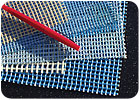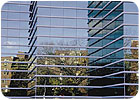
For a change of pace, I’ve decided to periodically write about contracting and field issues, including case studies of interesting projects. The idea is to offer insights that will help readers deal with aspects of EIFS in their work. Here’s one for starters.
I often do consulting regarding buildings with problems. While I don’t care much for the adversarial atmosphere when dealing with unhappy people and their lawyers, sometimes the problems involved are unique and worthy of discussion. Here are two examples of a sort of detective story. They involve a sports arena and some other buildings with a similar issue-the wall’s too hot.
THE ARENA
This is a huge building encompassing a sports arena and convention center that is fully enclosed and about a decade old. It’s at a high altitude in a sunny, dry region in the United States. The majority of the walls are EIFS. As luck would have it, someone was going in the special “executive entrance” and looked up and saw a bulging area of EIFS the size of a card table. This started a survey of the building to find out what was wrong. Was the wall falling off? It turned out the lamina was loose from the foam, and had bulged out like a big wart. The foam however, was still well-adhered to the substrate. On close inspection there were numerous areas with this problem.To fix a problem properly you usually need to know what’s causing it. Unless you know what is causing the problem, it’ll be just luck if you get a correct fix. There are lots of reasons why the lamina might be loose–but what was it in this case?
The first idea was that there was something wrong with the adhesive and/or the insulation. The next thought was that there was some foul-up by the contractor, but then why was this occurring only in certain areas?
Then the idea surfaced that it may be the heat from the sun, melting the foam. To find out, the building was encrusted with thermocouples to record how hot the wall really gets. The answer, after months of data taking, was: “Pretty hot, but probably not hot enough.”
Samples of the wall were taken to a lab, and-lo and behold-an old nemesis raised its head; the reinforcing mesh. Over a decade ago there was some mesh that had a coating that was not fully stable. It had chemicals in it that would dissolve the foam. This phenomenon, called “plasticizer migration” occurs more quickly when the temperature is elevated. The building’s EIFS finish is a dark brick-like red color, designed to harmonize with nearby old brick buildings.
Chemical analysis of the lamina showed that indeed this plasticizer was on the lamina–and on the foam surface.
The blisters were only occurring on the south and west side, which gets the most heat later in the day. The combination of extra heat and migrant plasticizer was enough to start the reaction, which luckily only affected parts of the building.

The blue coating on this mesh protects the glass from alkali in the Portland cement base coat, but also stiffens. Plasticizer chemicals can make the coating itself more flexible, and thus a limper mesh.
THE PREVALENT BLISTERS
Interestingly, the blisters were especially prevalent on wall areas where there was a low roof with shiny galvanized HVAC equipment and skylights on it, just below the EIFS. The sunlight bounced off the equipment and gave the EIFS an extra dose of energy.A settlement was reached and the parts of the building with the blisters were fixed. The fix involved removing the entire EIFS back to the substrate and installing a whole new EIFS. We tried to strip the lamina, but the foam was too badly damaged by the stripping process to allow reusing it. We also tried slicing a thin layer of foam (with the lamina intact) from the old foam, and then laminating a new thin layer of foam on top, and applying a new lamina. This proved cumbersome; it was easier to strip off the whole system. We did have good luck with using a hot wire to strip off the entire system at the adhesive-substrate interface. This was a smart move as it avoided damaging the gypsum board substrate.
EIFS is unusual as a product concept in that the lamina is thin and lightweight and has little ability to store heat energy. Thus when it is subjected to sunlight, its temperature rises quickly. Also, because it is backed up by insulation, the heat has nowhere to go. This makes the lamina hotter than if it were suspended like a sheet. Thus, the temperature of the lamina can, under extreme conditions, get too hot for the foam to endure. Contrast this behavior to a precast concrete wall, and consider how long it would take to heat up such a massive wall.
THERMOPLASTIC VERSUS THERMOSET
EPS and extruded polystyrene (Styrofoam) are thermoplastic plastics. This means they soften when heated and become hard again after the heat is removed. The maximum operating temperature of EPS, as used on the arena, is around 160 F. This characteristic is what makes hot wire foam cutting tools work. Thermosetting plastics, like urethanes and polyisocyanurates, have a higher maximum operating temperature. When overheated, they tend to char and decompose. Styrene plastics, like EPS, are more sensitive to solvents–as found in mesh coatings as plasticizer-than are polyiso foams. The amount and composition of plasticizers determine the stiffness of the mesh-from too stiff to bend easily (not good for EIFS) to very limp. The key, in the arena case, is that somehow some type of improper plasticizer got used on the mesh, and was not detected until it affected the EIFS wall.Oddly, I had seen this sort of heat-induced problem before, but in the upper Midwest. It was on a rooftop HVAC screen. The screen was made of EIFS, and the finish was jet black in color. There were skylights right next to it, beaming extra sunlight and heat energy onto the lamina. The entire lamina came loose –it was hanging from the parapet flashing like a curtain. In this case the mesh was not the issue, but the reflected extra heat was the cause.
There was a similar problem on a home in the desert. The walls were very dark green and on the south side there was a pool right next to the house. The reflection of sunlight off the pool’s surface made the walls so hot that the lamina came loose. To fix this problem a new lamina was installed with a lighter color. For added protection the owner added a floating plastic pool cover.

Mirror glass on buildings adjacent to an EIFS-clad building can beam extra sunlight onto the building’s wall.
EIFS AS SOLAR COLLECTOR
Speaking of pools, an architect approached me about using EIFS to heat his pool; well, sort of. He had this brainstorm to use EIFS as a solar collector by making large tilted EIFS panels and running pool water over a jet black lamina and then collecting the water and recirculating it to the pool. I warned him about foam getting too hot, and suggested he try using polyisocyanurate foam, which has a higher R-value and a higher maximum working temperature. He built his EIFS heater but the pool chemicals ruined the lamina. So he made a new heater using black painted aluminum plates with sprayed urethane on the back side.This problem of reflected sunlight also occurred overseas in Asia on a mid-rise office building. The EIFS was used as horizontal accent bands between the strip windows on each floor. The EIFS finish was alternating stripes of black and white. Across the street was an all glass curtainwall office building that used mirror glass. You guessed it-the glass building reflected sunlight onto the EIFS, and the EIFS got too hot and the lamina came loose. Oddly, the areas with white EIFS finish were unaffected.
Lesson Learned
These heat-induced problems had occurred a number of times before, but not on the scale of the arena building. The thing to keep in mind is that if you are using dark colors, consider the building’s orientation to the sun, latitude, altitude, nearby reflective surfaces, and the type of insulation. EIFS producers have technical data about the amount of absorption that various colors have from sunlight, and can advise how dark you can make the finish in a given climate area.Other than the mentally stimulating detective story aspects of the arena building, there is a happy part: When we were meeting at the arena, during a lunch break we went downstairs and got to meet the Dixie Chicks who were setting up for a concert. This was a memorable highlight of a workday in the desert.




Report Abusive Comment